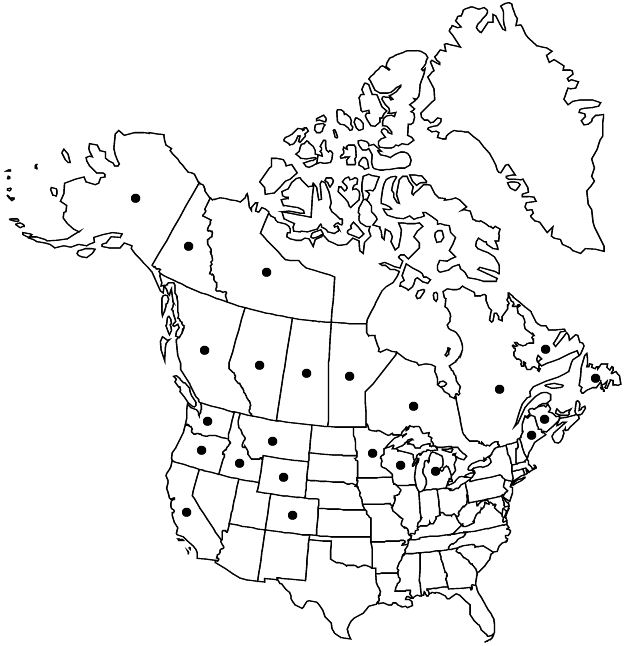Drosera anglica
Fl. Angl. ed. 2, 1: 135. 1778.
Plants forming winter hibernaculae, rosettes 2–6 cm diam.; stem base not bulbous-cormose. Leaves erect; stipules entirely adnate to petioles, 5 mm, margins fimbriate along distal 1/2; petiole differentiated from blade, 3–7 cm, glabrous or sparsely glandular-hairy; blade obovate to elongate-spatulate, 1.5–3.5(–5) cm × 3–7 mm. Inflorescences 1–12-flowered; scapes 3–25 cm, glabrous. Flowers 8–10 mm diam.; sepals connate basally, oblong, 5–6 × 4–5 mm, minutely glandular-denticulate; petals usually white, rarely pinkish, spatulate, 5–6 × 2–3.5 mm. Capsules 4–6 mm, minutely tuberculose. Seeds black, sigmoid-fusiform, 1–1.5 mm, length 1–2 times width, longitudinally striate-areolate. 2n = 40.
Phenology: Flowering Jun–Aug.
Habitat: Marly shores, fens, drainage tracks in peat bogs
Elevation: 10–2600 m
Distribution

Alta., B.C., Man., N.B., Nfld. and Labr., N.W.T., Ont., Que., Sask., Yukon, Alaska, Calif., Colo., Idaho, Maine, Mich., Minn., Mont., Oreg., Wash., Wis., Wyo., Eurasia, Pacific Islands (Hawaii).
Discussion
Drosera anglica is a boreal species that occurs on calcareous substrates. It often grows with D. rotundifolia in peat bogs, and with D. linearis and D. rotundifolia in marl fens, especially in the Great Lakes region. C. E. Wood Jr. (1955) presented a strong case for the hybrid origin of D. anglica, suggesting that it arose as a fertile amphiploid hybrid between D. rotundifolia and D. linearis. It is the only tetraploid North American species of Drosera with 2n = 40. The sterile hybrid D. rotundifolia × D. linearis may be found whenever these species grow together. To avoid confusion, and because a formal name for the sterile hybrid has not been published, it should not be called Drosera ×anglica Hudson, as is commonly done. According to D. E. Schnell (2002), the fertile species may be distinguished from the sterile hybrid by its wider flowers (8–10 mm versus 6–7 mm) and wider scapes (1.5–2 mm versus 1–1.2 mm).
The hybrid between Drosera rotundifolia and D. anglica is a sterile triploid, and has been formally named Drosera ×obovata Mertens & W. D. J. Koch.
Because Drosera longifolia Linnaeus cannot be convincingly typified and has been so often used for plants of D. anglica and D. intermedia in the literature (F. E. Wynne 1944), the name D. longifolia has been rejected as ambiguous.
Drosera anglica is found in the Aalakai Swamp at 1500–2000 meters on the Hawaiian island of Kauai (perhaps brought by migrating birds from Alaska); it is otherwise found in cold northern climates. D. E. Schnell (2002), who has grown the Kauai plants from seed, postulated that the high elevation provides a cooler temperature, and noted that plants from there do not form winter hibernaculae but only smaller winter rosettes.